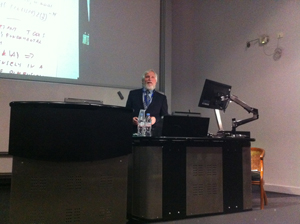
Easy as 1, 2, 3?
The natural numbers, 1, 2, 3, 4, ..., are nice. We all understand them and we use them countless times every day. So what could be nicer than discovering interesting patterns within them?

What secrets do the natural numbers hold?
Endre Szemerédi, one of the main speakers at this year's British Mathematical Colloquium (BMC) and winner of the 2012 Abel prize, is interested in the simplest kind of pattern you can find within a collection of natural numbers: sequences of numbers that are all evenly spaced, with successive numbers all having the same distance between them. Examples are
2, 4, 6, 8, 10, 12,
a sequence of length 6 in which successive numbers are a distance 2 apart, or
4, 7, 10, 13, 16, 19, 22, 25,
a sequence of length 8 in which successive numbers are a distance 3 apart.
Such sequences are called arithmetic progressions. One very natural question to ask is this: given a collection of natural numbers, what is the longest arithmetic progression you can find within it? If your collection is small, then you can answer the question just by looking at it. But what if the collection is very large or even infinite? And what if you don't even know the exact numbers your collection contains?
Question like these have led to some very sophisticated mathematics. In 2006 the Australian mathematician Terence Tao was awarded the Fields medal, one of the highest honours in maths, partly for his work on arithmetic progressions within the prime numbers 2, 3, 5, 7, 11 ... . A quick look at the first few primes already reveals two short arithmetic progressions:
3, 5, 7
and
3, 7, 11.
The question is, are there longer ones hidden within the infinitely many primes?
Endre Szemerédi talking at the BMC.
Together with the British mathematician Ben Green Tao proved that the answer is yes. In fact, the primes contain arithmetic progressions of arbitrary length: no matter how large a number n you choose, you can be sure that there is an arithmetic progression of length n hidden somewhere within them. This doesn't mean, however, that you actually know what the prime numbers in this progression are: the proof only tells you that the progression exists. The longest arithmetic progression within the primes we actually know is only 26 numbers long. It was found in February 2014.
At the BMC Szemerédi was talking about another type of number collection within which you can look for arithmetic progressions. Given a collection $A$ of numbers, or a set of numbers as it's properly called, you can make a new set, called $A+A$, which consists of all the numbers you get by adding two numbers in $A$. For example, if $A$ consists of the numbers 1, and 3, $$A = \{1,3\},$ then $$A+A = \{1+1=2, 1+3=4, 3+3=6\} = \{2, 4, 6\}.$$ In this example the new set $A+A$ contains an arithmetic progression of length 3 with spacing 2 between numbers, namely 2, 4, 6. This was easy to see, but can you say anything about arithmetic progressions in $A+A$ when you don't know which numbers the original set $A$ contains?
Terence Tao won the 2006 Fields medal for his work on arithmetic progressions.
And this is indeed true. In 2002 Ben Green, who we already met above, proved a result to show this, extending work done previously by another Fields medallist, Jean Bourgain. Suppose that $A$ is a set containing some of the natural numbers from 1 up to some number $N$ and that the size of the set $A$ is $d \times N$, where $d$ is some number between 0 and 1 (so if the size of $A$ is half of $N$, then $d=1/2$). Then you can be sure that $A+A$ contains an arithmetic progression of length at least $$e^{c\sqrt{{\log{N}}}},$$ where $c$ is a positive number that only depends on $d$ and not on the original set $A$ or the number $N.$ (Here $e = 2.71828...$ is the basis of the natural logarithm.)

Ben Green has contributed important results to the search for arithmetic progressions. Image: Renate Schmid, copyright MFO.
We talked to Endre Szemerédi at the British Mathematical Colloquium 2014, which took place at Queen Mary, University of London last week. You can read more about mathematics at the BMC here. To find out more about intriguing number theory questions, see here.